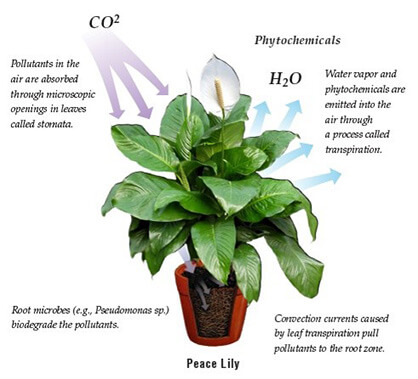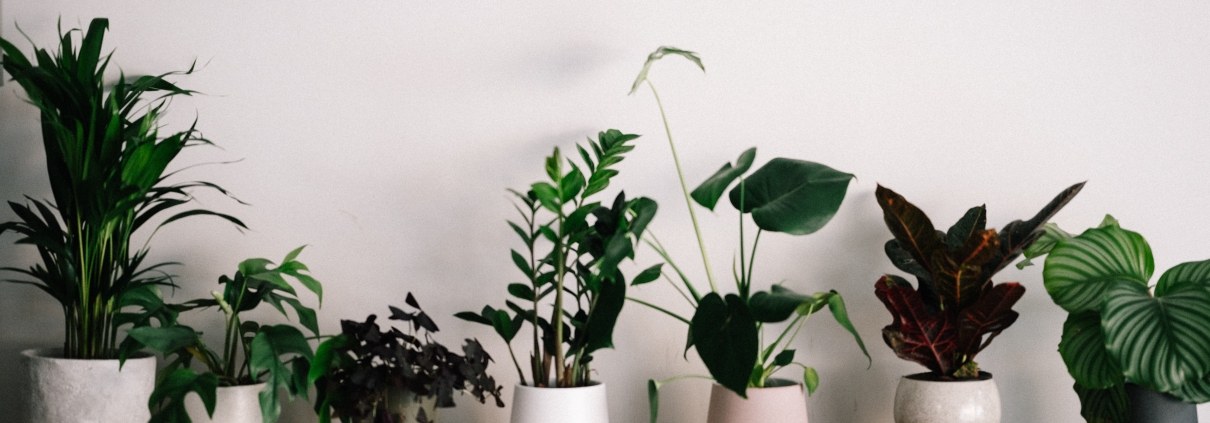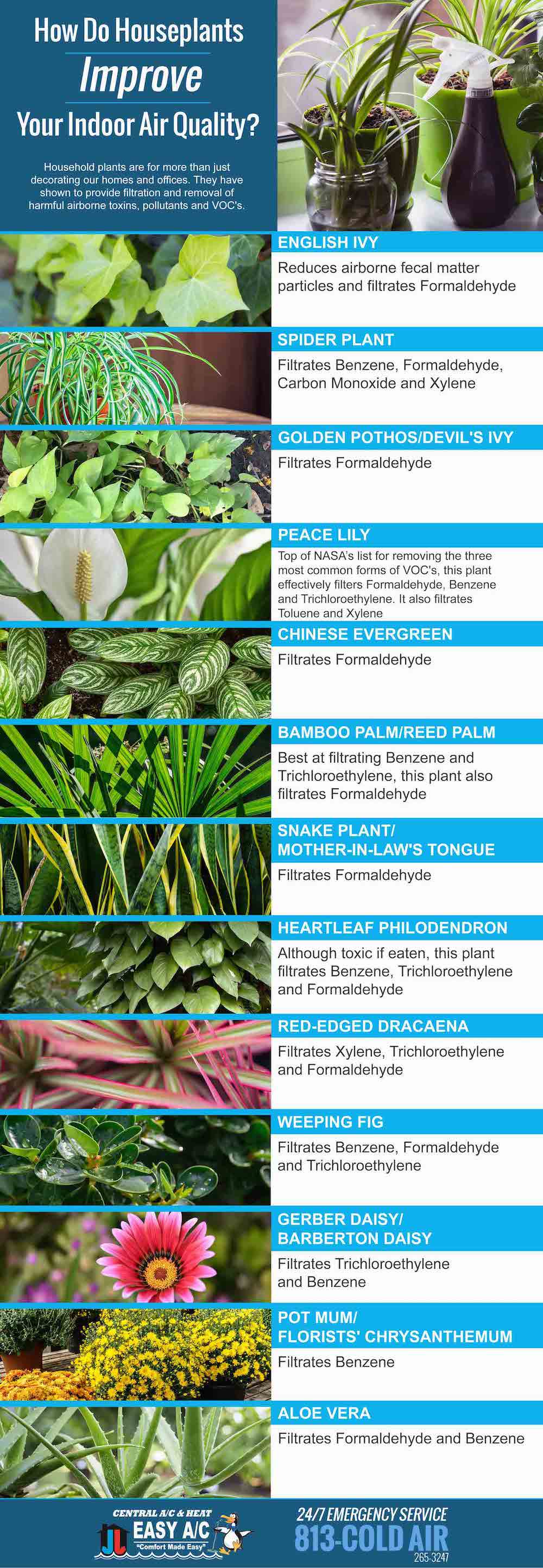Indoor plants can improve air quality by removing toxins and increasing humidity. Their impact, however, is generally minimal in typical home settings.
Indoor plants have gained popularity for their aesthetic appeal and potential health benefits. Many people believe that houseplants can significantly improve air quality. While plants do remove some toxins, their overall impact on air quality in a standard home is limited.
NASA’s research indicates that plants can absorb pollutants, but the effect is small unless a large number of plants are used. Despite this, indoor plants still offer other advantages like reducing stress, boosting mood, and enhancing the living environment. For those seeking to improve air quality, combining plants with other methods is more effective.

Credit: planterra.com
Introduction To Indoor Air Quality
Indoor air quality affects our health every day. Clean air is essential for a healthy life. Many people spend most of their time indoors. This makes indoor air quality very important.
The Importance Of Clean Air
Clean air helps us breathe easier. It reduces the risk of allergies and asthma. Good air quality also boosts our mood and energy. Clean air at home and work is crucial for well-being.
Common Indoor Pollutants
There are many indoor pollutants. Here are some common ones:
- Dust: Small particles from various sources.
- Mold: Grows in damp areas.
- Pet dander: Tiny particles from pets.
- Household chemicals: From cleaners and sprays.
- Smoke: From cooking or tobacco.
These pollutants can cause health problems. They make it harder to breathe. Indoor plants can help reduce these pollutants. They act as natural air filters.

Credit: www.breeze-technologies.de
The Basics Of Indoor Plants
Indoor plants are more than just decor. They bring life to your space. They also improve air quality. Let’s explore the basics of indoor plants.
Types Of Indoor Plants
Indoor plants come in various types. Here are some popular ones:
- Spider Plant – Easy to grow and purifies air.
- Snake Plant – Removes toxins and needs little water.
- Peace Lily – Beautiful flowers and cleans air.
- English Ivy – Reduces mold and is easy to maintain.
- Aloe Vera – Heals skin and purifies air.
How Plants Purify Air
Plants purify air through a process called photosynthesis. They take in carbon dioxide and release oxygen. This helps improve air quality.
Here are some ways plants clean the air:
- Absorbing Toxins – Plants can absorb harmful chemicals like formaldehyde.
- Releasing Oxygen – During photosynthesis, plants release oxygen.
- Reducing Dust – Leaves can trap dust, making the air cleaner.
The table below shows how different plants purify air:
| Plant | Removes |
|---|---|
| Spider Plant | Formaldehyde, Xylene |
| Snake Plant | Benzene, Trichloroethylene |
| Peace Lily | Ammonia, Benzene |
| English Ivy | Mold, Benzene |
| Aloe Vera | Formaldehyde, Benzene |
In summary, indoor plants are great for improving air quality. They absorb toxins, release oxygen, and reduce dust. Choose the right plants to enjoy cleaner air.
Scientific Evidence On Plants And Air Quality
Many believe indoor plants improve air quality. But what does science say? Let’s look at key studies and findings, and explore the limitations of current research.
Key Studies And Findings
NASA’s Clean Air Study is a famous research. It found that plants can remove toxins like benzene, formaldehyde, and trichloroethylene. Some of the best air-purifying plants include:
- Spider Plant
- Snake Plant
- Peace Lily
Another study by the American Society for Horticultural Science showed that plants can reduce carbon dioxide levels. This study found that plants like the Areca Palm and Boston Fern are very effective.
Researchers also discovered that plants can increase humidity. This helps in reducing respiratory issues.
Limitations Of Current Research
Most studies were conducted in controlled environments, not real homes. This makes it hard to say if results apply to everyday situations.
Another issue is the number of plants needed. Some studies suggest you need many plants for a noticeable effect. This is not practical for small spaces.
Additionally, the type of soil and plant health can affect results. Poor soil can limit a plant’s ability to purify air.
Finally, plants can also produce allergens. This can be a problem for people with allergies.
Top Air-purifying Plants For Your Home
Indoor plants can make your home feel fresh and lively. They also improve air quality. Some plants are better at this than others.
Spider Plant
Spider Plant is a great choice. It cleans the air very well. It removes toxins like formaldehyde and xylene. Spider Plants are easy to care for. They need indirect sunlight and water once a week.
Snake Plant
Snake Plant is another top plant. It can filter out benzene and trichloroethylene. Snake Plants are also known as Mother-in-Law’s Tongue. They can live in low light. Water them every two to three weeks.
Peace Lily
Peace Lily is a beautiful plant. It removes many toxins like ammonia, benzene, and formaldehyde. Peace Lilies have white flowers. They need low light and water once a week. Be careful, as Peace Lilies can be toxic to pets.
| Plant | Toxins Removed | Care Needs |
|---|---|---|
| Spider Plant | Formaldehyde, Xylene | Indirect sunlight, weekly watering |
| Snake Plant | Benzene, Trichloroethylene | Low light, water every 2-3 weeks |
| Peace Lily | Ammonia, Benzene, Formaldehyde | Low light, weekly watering |
These plants not only purify the air but also add beauty to your home. Choose one or more and enjoy cleaner air!
How Plants Improve Health And Well-being
Indoor plants do more than just beautify spaces. They can improve our health and well-being. Plants can create a healthier indoor environment. This section will explore their benefits for physical and mental health.
Physical Health Benefits
Indoor plants can remove toxins from the air. They can reduce levels of carbon dioxide. This can lead to better breathing. Some plants can increase humidity. This helps to prevent dry skin and respiratory problems. Plants like spider plants and peace lilies are good examples.
Plants can also lower stress levels. They can reduce blood pressure. This can lead to a healthier heart. Studies show that having plants can reduce recovery times. Patients in hospitals heal faster with plants around.
Plants can improve indoor air quality. This can reduce symptoms of allergies. They can trap dust and other particles. This makes the air cleaner to breathe.
Mental Health Improvements
Plants can boost our mood. They can reduce feelings of anxiety. This makes us feel happier and more relaxed. Being around plants can increase productivity. They can help us focus better on tasks.
Studies show that plants can improve our cognitive functions. They can help with memory retention. This makes learning easier.
Plants can create a calming environment. They can reduce feelings of fatigue. This makes us feel more energetic and refreshed.
Here is a table showing some popular indoor plants and their benefits:
| Plant | Benefit |
|---|---|
| Spider Plant | Removes toxins, increases humidity |
| Peace Lily | Reduces mold spores, improves air quality |
| Snake Plant | Converts CO2 to oxygen at night |
| Aloe Vera | Heals skin, improves air quality |
Adding indoor plants can transform any space. They not only improve air quality but also enhance our health and well-being.
Plant Care And Maintenance
Taking care of indoor plants is crucial for improving air quality. Proper care ensures plants thrive and purify the air efficiently. Here’s a guide on plant care and maintenance to help you get started.
Watering Essentials
Water is vital for plants to grow and stay healthy. Indoor plants have different watering needs. Overwatering or underwatering can harm them.
- Check soil moisture before watering.
- Use a pot with drainage holes.
- Water thoroughly but let soil dry before next watering.
A simple trick is to stick your finger into the soil. If it feels dry an inch down, it’s time to water. Avoid letting plants sit in water to prevent root rot.
Light And Temperature Needs
Light is another key factor for plant health. Different plants need different light levels. Some love bright light, others prefer shade.
| Plant Type | Light Needs |
|---|---|
| Snake Plant | Low to Bright, indirect light |
| Spider Plant | Bright, indirect light |
| Aloe Vera | Bright, direct light |
Temperature also affects plant growth. Most indoor plants thrive in temperatures between 65°F and 75°F. Sudden temperature changes can stress plants.
- Keep plants away from drafts.
- Avoid placing near heaters or air conditioners.
- Maintain consistent room temperature.
By following these simple care tips, your indoor plants will flourish. Healthy plants improve air quality and bring nature indoors.
Designing Your Indoor Garden
Creating an indoor garden not only beautifies your space but also boosts air quality. Knowing how to design your garden helps maximize these benefits. This section guides you on choosing the right plants and layout ideas for small spaces.
Choosing The Right Plants
Picking the right plants is key to a healthy indoor garden. Some plants are excellent at purifying the air. Here are a few that excel at this task:
- Spider Plant: Great for removing toxins like formaldehyde.
- Snake Plant: Known for its ability to produce oxygen at night.
- Peace Lily: Effective at removing mold spores from the air.
- Aloe Vera: Helps to clear benzene and formaldehyde.
Layout Ideas For Small Spaces
Even small spaces can host a thriving indoor garden. Using creative layout ideas can help optimize your space.
Here are some suggestions:
- Vertical Gardens: Use shelves or wall-mounted planters to save floor space.
- Hanging Planters: Suspend plants from the ceiling to add greenery without taking up room.
- Window Sills: Place small pots on window sills to get natural light.
- Corner Stands: Utilize corner plant stands to make use of otherwise wasted space.
Table Of Air-purifying Plants And Their Benefits
| Plant | Benefits |
|---|---|
| Spider Plant | Removes formaldehyde, easy to care for |
| Snake Plant | Produces oxygen at night, removes toxins |
| Peace Lily | Removes mold spores, low light friendly |
| Aloe Vera | Clears benzene and formaldehyde, medicinal uses |

Credit: www.easyac.net
Myths Vs. Facts: The Real Impact Of Indoor Plants
Indoor plants are often hailed as miracle workers for air quality. While they offer several benefits, there are misconceptions. This section delves into the myths and facts. Let’s clarify the real impact of indoor plants on air quality.
Debunking Common Myths
Several myths surround the idea of indoor plants improving air quality. Let’s debunk these myths.
- Myth 1: Indoor plants can completely purify indoor air.
- Fact: Plants alone can’t remove all indoor pollutants.
Studies show plants help, but they can’t replace ventilation systems. They only remove small amounts of toxins.
- Myth 2: More plants mean cleaner air.
- Fact: Having many plants doesn’t guarantee air purification.
Each plant has a limited capacity to absorb toxins. Overloading your space with plants won’t drastically improve air quality.
Understanding The Realistic Benefits
Despite the myths, indoor plants still offer realistic benefits for air quality. Here’s what they actually do.
- Benefit 1: Indoor plants increase humidity.
Plants release moisture through a process called transpiration. This can make the air more comfortable, especially in dry environments.
- Benefit 2: Plants reduce levels of carbon dioxide.
While they can’t remove all pollutants, plants can lower CO2 levels. This makes the air feel fresher.
- Benefit 3: Some plants can absorb specific toxins.
Certain plants can absorb harmful chemicals like formaldehyde and benzene. Examples include spider plants and peace lilies.
Table: Plants And Their Air Purifying Capabilities
| Plant | Toxin Absorbed |
|---|---|
| Spider Plant | Formaldehyde, Xylene |
| Peace Lily | Ammonia, Benzene |
| Snake Plant | Trichloroethylene, Formaldehyde |
Indoor plants offer benefits but aren’t a complete solution. Proper ventilation and air purifiers are also important for clean air.
Frequently Asked Questions
Do Plants Really Help Indoor Air Quality?
Yes, plants can improve indoor air quality. They absorb pollutants, release oxygen, and increase humidity. Popular choices include spider plants, peace lilies, and snake plants. Adding a few indoor plants can make your home healthier and fresher.
How Much Do Houseplants Purify Air?
Houseplants can improve air quality by removing toxins, but their impact is minimal. They complement, not replace, other air purifiers.
Do Houseplants Really Increase Oxygen?
Yes, houseplants increase oxygen through photosynthesis. They absorb carbon dioxide and release oxygen, improving indoor air quality.
Do You Think House Plants Improve The Quality Of Indoor Air?
Yes, house plants can improve indoor air quality. They absorb carbon dioxide and release oxygen, reducing indoor pollutants.
Conclusion
Indoor plants can significantly improve air quality by reducing pollutants and increasing oxygen levels. They are a simple, cost-effective solution for healthier living spaces. By incorporating various indoor plants, you can enjoy cleaner air and a more pleasant environment. Start enhancing your indoor air quality with the right plants today.

My mission is to help you bring the beauty of nature indoors with expert advice, detailed plant care guides, and creative design ideas.




